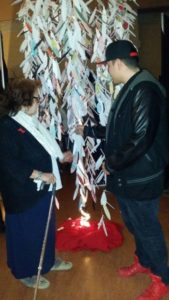Shades of Our Sisters installation receives overwhelming support

By Barb Nahwegahbow
TORONTO—Joyce Carpenter and Mag Cywink were overwhelmed with the love and support from the opening night crowd at Shades of Our Sisters. About 200 people crowded into Ryerson University’s Tecumseh auditorium with more lined up outside to view the installation. Shades of Our Sisters celebrates the lives of two missing and murdered Indigenous women – Patricia (Trish) Carpenter and Sonya Cywink.
Joyce Carpenter’s 14-year-old daughter, Trish was a new mom when she died in Toronto in 1992. Her son, Dakota was just two months old. Her death remains unresolved.
Sonya Cywink, Mag’s 31-year-old sister was pregnant when she was killed near London, Ontario, in 1994. Her killer has never been found.
The installation undertaken by a group of fourth year media students at Ryerson focuses on the lives of the women rather than their deaths.
“I want people to know my girl,” said Joyce Carpenter in the room dedicated to Trish.
Three Cabbage Patch dolls that Trish played with as a little girl and the baby sleeper she wore home from the hospital are on display. Recordings of her favourite poetry and some of her own writings show her creative and pensive side. The MacDonald’s job application she completed on behalf of her two-month old son shows her sense of humour, recalled Carpenter, also adding that she did this just 10 days before she died.
In Sonya’s room, you can listen to her favourite music on cassette tapes and read her handwritten letters to her family, including the last letter she wrote to her father. There are childhood photos and in most of them, she is laughing. The original cross from Sonya’s grave has a place of prominence in the room dedicated to her; a grim reminder of the loss to her much-loved and boisterous family.
Documentaries produced by the Ryerson team running approximately 20-minutes in length on each of the women are the core of the installation. Their relationships with sisters, brothers, mother, nieces, and friends come to life during the interviews discussing their memories of Sonya and Trish. Not only have their families suffered a great loss, but so have their friends and communities.
“We’re all media students at Ryerson,” said spokesperson Laura Heidenheim. “…We saw an issue with the representation of Indigenous women in the media, specifically Indigenous women who’ve been killed. It seemed that the language used when their stories are covered is totally insensitive. Most times you can tell that the families weren’t actually consulted about how they want their stories told. The media just went for it and we wanted to do something to help that.”
The students met weekly with the respective families and the stories told in the films and throughout the entire exhibition indeed reflect their participation. Their stories are told with sensitivity and compassion, focusing on their relationships with family and friends, and on the lives lived.
“The families taught us so much—about love, respect and strength and about the right way to tell these stories,” stated Heidenheim.
The families of the two women are the producers of the project.
“Seeing the numbers going through makes me feel empowered and peaceful,” shared Cywink. “And it makes me happy to know that people care, that they’re being affected.”
The broad range of ages, from 10 years to 85 years is particularly encouraging, she added.
After three days at Ryerson, the exhibition was installed for two days at Alderville First Nation, Carpenter’s home community. The third planned stop is Espanola High School where Sonya Cywink, a member of Whitefish River First Nation attended high school.


